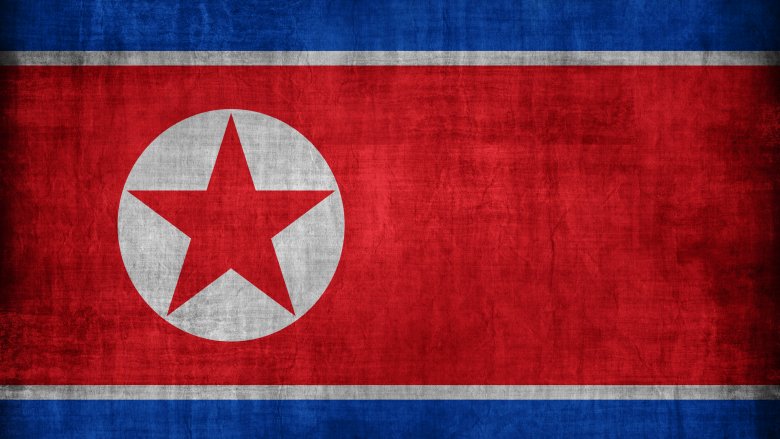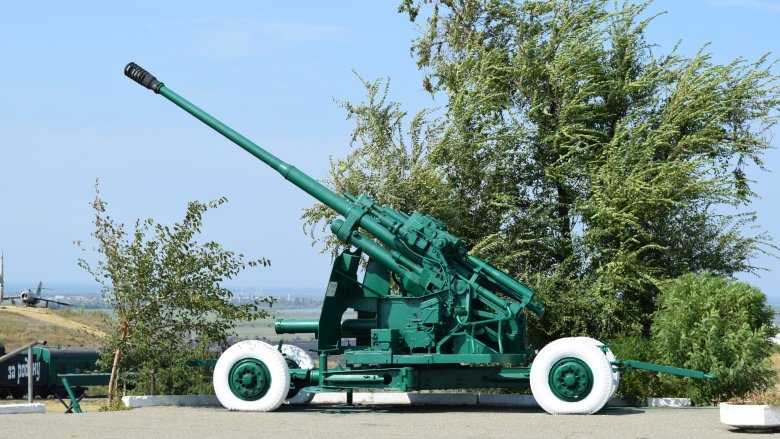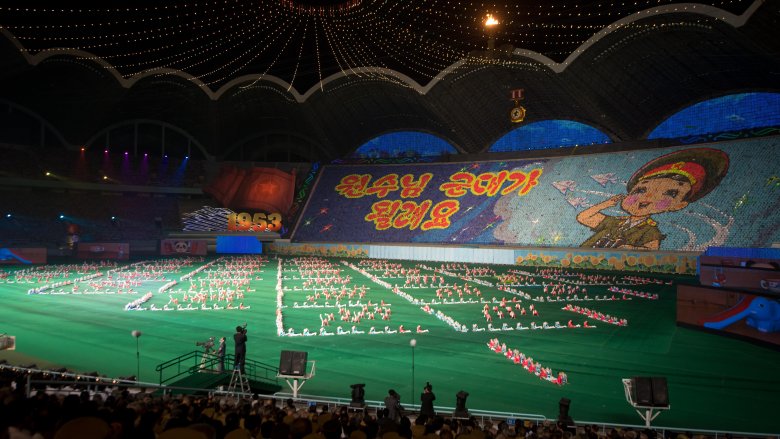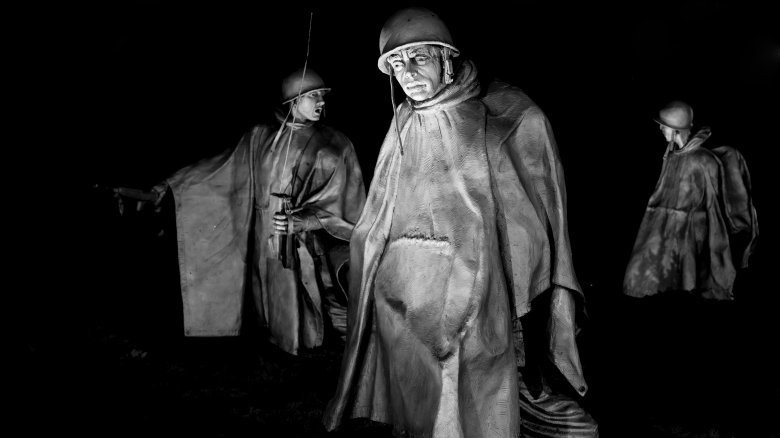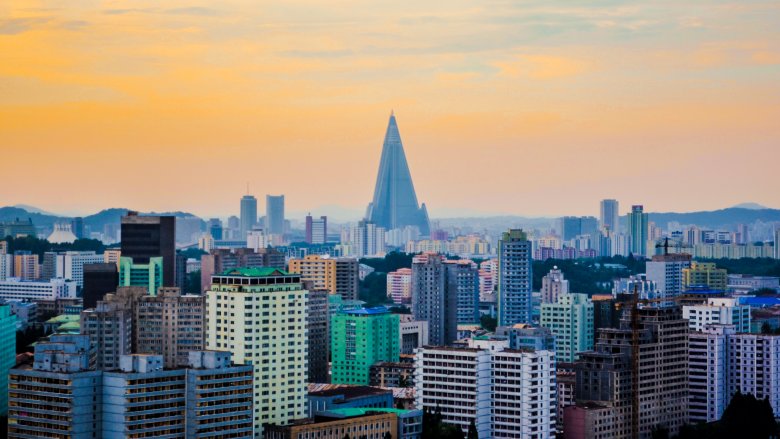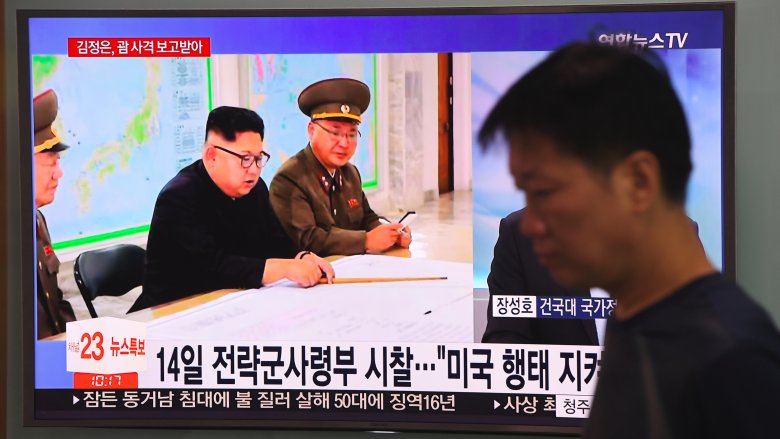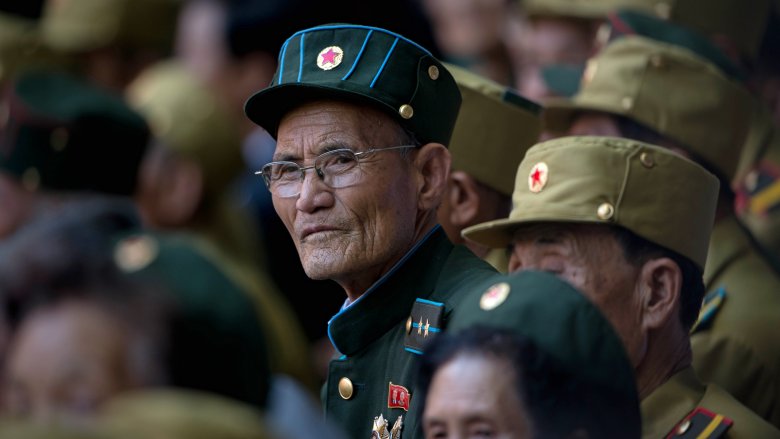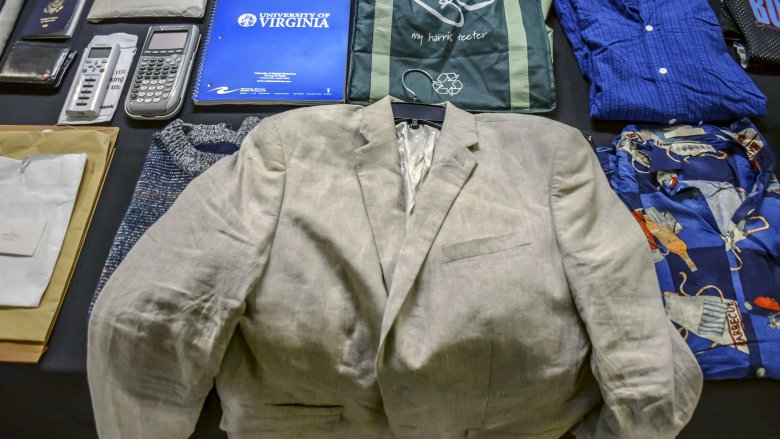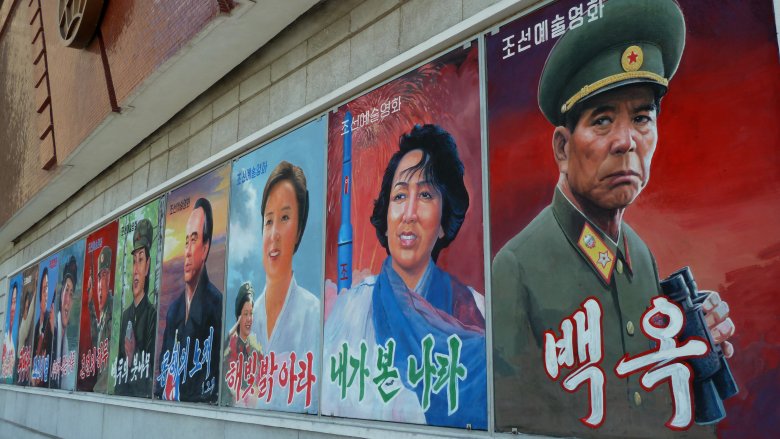Messed Up Things That Actually Happened In North Korea
There's a lot to find funny about North Korea. From the absurdly generous full name (the Democratic People's Republic of Korea) to the bizarre, amateurish official website to the countless reports and stories in the press of inhuman feats of strength performed by its dictators, outlandish threats toward its enemies, and strange transgressions committed by its own senior officials, it's easy to see the DPRK as a big geopolitical joke. In truth, however, it's anything but. Underneath the outlandish remarks and cartoonish villainy lies a totalitarian regime that employs murder, torture, and kidnapping on a massive scale to oppress its impoverished, starving population. The following events make up only a small fraction of the known crimes against humanity that are alleged to be committed every single day by Kim Jong-un's regime.
Death by anti-aircraft
Executions in the DPRK are likely no rarity, but because they so often take place without the knowledge of international observers — like if they happen inside the country's concentration and prison camps — it's difficult to know just how many are killed by the regime each year. Occasionally, however, an execution will take place that's high-profile enough to make world headlines.
This was the case in 2016, when, according to the South Korean media, a government purge of officials who were deemed to be a threat to the regime led to the arrest and subsequent execution of two ministers: Hwang Min, agriculture minister, and Ri Yong-jin, who worked at the education ministry. Purges are common in the country, and executions usually follow, but it was the nature of these executions that made them so noteworthy — Hwang and Ri (the latter of whom was said to have been purged for falling asleep in a meeting with Kim Jong-un) were executed by anti-aircraft gun, likely as a show of force to instill fear in other government officials.
According to South Korean lawmakers who had been briefed by the intelligence services, five more people were killed with this method in early 2017, setting a terrifying precedent for murder in the DPRK.
Very, very public executions
Inhumane executions aren't just reserved for the higher-ups in North Korea, though, and ordinary citizens or peasants can just as easily find themselves meeting vicious, grisly ends. This was the case in 2007, when, according to Good Friends — an aid organization that focuses on the DPRK — a factory manager from Suncheon was killed for covering up the fact that his father was a part of the pre-Kim government. He was also convicted of investing private money and making international phone calls.
Unlike most, who would have been murdered in a prison camp, the factory manager was instead made an example of, executed in a stadium in his home town. The report stated that up to 170,000 people were present for the execution of the 74-year-old. Worse still, six people were said to have been killed leaving the stadium because of the sheer size of the crowd, while a number of other officials "connected" to the incident were also fired. In the DPRK, it's probably safe to assume that being let go doesn't consist of a stern talking-to and a severance package.
The fate of American POWs
During the Korean War, a young soldier named Wayne Minard — who joined the army at 17 and had served for only two years in the military — went missing in action after Chinese troops attacked U.N. forces near the Ch'ongch'on River. According to the Defense POW/MIA Accounting Agency, Minard died in February 1951, only months later, of starvation in an enemy prison camp. The nature of Minard's death is no anomaly in the Korean War, and the lists of missing troops, many of whom were likely murdered in the camps are very long indeed.
Most shocking of all, however, is that Minard's remains were only returned to the United States in late 2016, well over half a century later. Even in 2017, almost 8,000 Americans remain unaccounted for from the Korean War. The maltreatment of POWs by the regime in its early days means that many soldiers, who were captured and later killed, have never been returned home for a proper burial — and likely never will be.
The plunder order
Starvation is a specter that looms over many of the ordinary citizens of North Korea, and food aid has long been part of negotiations with the country. In the summer of 2017, however, matters worsened somewhat with the implementation of an order by the regime for soldiers to plunder farms for corn in order to feed themselves.
A North Korean source told the media in Seoul that these soldiers, who are malnourished largely due to exhaustion from training, have been ordered to steal to eat in order to keep their strength up for what the military believes could be an impending war against South Korea, Japan, or the United States. As a result, farmers are reportedly being forced to defend their farms against the military, and soldiers themselves are said to be selling the stolen corn at markets across the Ryanggang province.
Songbun
The songbun system — "songbun" means "ingredient" or "background" — was an identification caste set up by the North Korean government in the late 1960s. As Kim Il-sung tightened his grip on the country, he implemented the system as a way of identifying which citizens were potential threats to the new regime. Based on their own actions and the actions of their parents, over three million citizens were ranked as core, wavering, or hostile.
If you were close to Kim or if you had been a resistance fighter against the Japanese, you became part of the core class. If you had been a landowner, businessman, or intellectual under Japanese rule, you were part of the hostile class. Your class dictated where you were allowed to live, what job you held, and whether you were likely to be persecuted by the state.
The songbun system fell apart after a famine in the 1990s, when North Koreans realized they could climb in social status by bribing government officials. Nowadays, the country is so corrupt that many are able to buy their way out of punishment for crimes or access areas of society they couldn't reach before. The system just exists in a different form — those who are unable to bribe their way into an easy life are still oppressed by the first government's grand design.
The totalitarian Netflix
Among all the death, torture, and starvation, it's still pretty remarkable — unsettling, even — to watch how North Korea's government attempts to instill a sense of loyalty and patriotism in its subjects. Recently, for example, the country's state media announced plans to set up its own streaming service for television. In a bizarre move that sounds like something taken out of a tacky reboot of 1984, the service, known as "Manbang" in Korean (yes, har har), would allow citizens to watch up to five different channels, each showing documentaries, news reports, and articles ... approved and sponsored by the government.
Despite the state media claims, however, many are skeptical of Manbang's existence, largely because there's next to no internet availability in the country. As it stands, this form of Orwellian populace control is unlikely to come to fruition.
The ax murder incident
The ax murder incident is one of the more notorious events in the history of relations between North Korea and the United States. On August 18, 1976, a group of U.S. Army soldiers set off into the Demilitarized Zone to cut down a poplar tree blocking the view of the "Bridge of No Return" across the DMZ. Two officers in the group were axed to death during the trip by North Korean guards from a treaty village between the two nations.
A crisis ensued. Three days later, two platoons of the Joint Security Force were sent to cut down the tree in a show of force against the DPRK. The North responded by sending up to 200 fully-armed troops. Machine gun positions were set up, troops were placed on standby, and an air force base in Japan went on full alert. Eventually, the tree was felled without further confrontation. Today, the stump — all that's left of the tree — stands as a stark reminder of how easily tensions between the forces in the DMZ can escalate into something altogether more terrifying.
Pressuring the elderly into suicide
In recent years, thanks to more expensive medicine, increasing starvation, and a growing apathy toward elders, many North Korean families are pressuring their older members into suicide.
According to Radio Free Asia, which cited a source in the North Hamgyong province, the elderly — who find it difficult to live under a strained welfare system — are leaving their homes during the day to avoid conflict with their children. Because of the financial burden of caring for an elderly person, many adults are asking their parents (some of whom are Korean War veterans) to kill themselves for the sake of the family. Unsurprisingly, this is not a problem for the higher ranks of North Korean citizens and leaders.
The death of Otto Warmbier
Of the few American citizens who have been detained by the North Korean regime while visiting over the years, the case of Otto Warmbier might be the most well-known — and horrifying. Aged just 22, he was held in North Korea in January 2016 for allegedly stealing a propaganda poster from his hotel room, where he'd been staying while touring the country. Warmbier, who was a student at the University of Virginia, was sentenced to 15 years of hard labor in a trial that allegedly took less than an hour.
In 2017, Warmbier was returned from North Korea to the United States in a state of unresponsive wakefulness, heavily brain damaged. He was unable to speak, to see, or to react to verbal commands. Warmbier died soon after arriving home. Despite protests from the regime, it's assumed that he sustained his injuries through beatings and torture by the North Koreans. Three Americans are still jailed in North Korea.
Pulgasari
It isn't unheard of for the DPRK to employ kidnapping beyond its borders to further its own aims. One of the more bizarre cases of kidnapping involved Shin Sang Ok, a popular South Korean film director. Shin's wife, a film star herself, was lured to China and abducted by the North Koreans; Shin was taken while attempting to track her down. At the behest of Kim Jong-il, Shin was forced to produce and direct seven films starring his wife. Most famous of these is Pulgasari, a Godzilla flick in which the titular monster fights and defeats a villainous emperor.
The film was a hit in North Korea and impressed Kim — enough that he started to warm up to them. When they were allowed to visit Vienna for "business," they fled to a U.S. embassy. Pulgasari was banned from North Korean theaters shortly after.
The Japanese abductions
Most kidnappings by the North Korean state, however, are a little less whimsical than the case of Shin Sang Ok. Over the course of the 1970s and '80s, the DPRK abducted at least a dozen Japanese citizens and brought them to North Korea. Kim Jong-il admitted in 2002 that the kidnappings (which included a beautician, a schoolgirl, and a young couple who were plucked off a beach) did indeed take place, insisting that they were committed solely by "reckless" special forces. He also revealed that eight of the missing had died, with four still living in Pyongyang.
According to the regime, the victims were taken so they could teach Japanese to North Korean spies, and in order to provide false identities for spies who would enter North Korea. Many suspect the North Korean government of having murdered at least some of the missing after rumors sprang up about the abductions in the 1990s.
